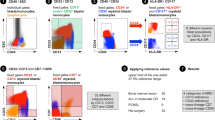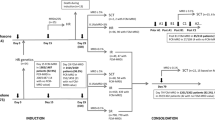Abstract
The European BIOMED-1 Concerted Action was initiated in 1994 to improve and standardize the flow cytometric detection of minimal residual disease (MRD) in acute leukemia (AL). Three different protocols were defined to identify the normal subsets of B, T and myeloid cells in bone marrow (BM), and were applied to the different types of AL in order to study aberrant immunophenotypes. Using sensitive acquisition methods (‘live gate’) T cell subsets in normal BM could be identified with five triple-stains: CD7/CD5/CD3, CD7/CD4/CD8, CD7/CD2/CD3, CD7/CD38/CD34 and TdT/CD7/surface or cytoplasmic (cy)CD3 (antibodies conjugated with FITC/PE/PECy5 or PerCP, respectively). The identification of T cell subsets in BM allowed definition of ‘empty spaces’ (ie areas of flow cytometric plots where normally no cells are found). All studied T-ALL cases (n = 65) were located in ‘empty spaces’ and could be discriminated from normal T cells. The most informative triple staining was TdT/CD7/cyCD3, which was aberrant in 91% of T-ALL cases. In most cases, two or more aberrant patterns were found. Apparently the immunophenotypes of T-ALL differ significantly from normal BM T cells. This is mostly caused by their thymocytic origin, but also the neoplastic transformation might have affected antigen expression patterns. Application of the five proposed marker combinations in T-ALL contributes to standardized detection of MRD, since cells persistent or reappearing in the ‘empty spaces’ can be easily identified in follow-up BM samples during and after treatment.
This is a preview of subscription content, access via your institution
Access options
Subscribe to this journal
Receive 12 print issues and online access
$259.00 per year
only $21.58 per issue
Buy this article
- Purchase on Springer Link
- Instant access to full article PDF
Prices may be subject to local taxes which are calculated during checkout



Similar content being viewed by others
References
Janossy G, Bollum FJ, Bradstock KF, Ashley J . Cellular phenotypes of normal and leukemic hemopoietic cells determined by analysis with selected antibody combinations Blood 1980 56: 430–441
van Dongen JJ, Krissansen GW, Wolvers-Tettero IL, Comans-Bitter WM, Adriaansen HJ, Hooijkaas H, van Wering ER, Terhorst C . Cytoplasmic expression of the CD3 antigen as a diagnostic marker for immature T-cell malignancies Blood 1988 71: 603–612
Ludwig WD, Harbott J, Bartram CR, Komischke B, Sperling C, Teichmann JV, Seibt-Jung H, Notter M, Odenwald E, Nehmer A . Incidence and prognostic significance of immunophenotypic subgroups in childhood acute lymphoblastic leukemia: experience of the BFM study 86 Rec Res Cancer Res 1993 131: 269–282
van Dongen JJ, Adriaansen HJ . Immunobiology of leukemia. In: Henderson ES, Lister TA, Greaves MF (eds) Leukemia 6th edn: WB Saunders: Philadelphia 1996 pp 83–130
Campana D, Coustan-Smith E, Behm FG . The definition of remission in acute leukemia with immunologic techniques Bone Marrow Transplant 1991 8: 429–437
van Dongen JJ, Breit TM, Adriaansen HJ, Beishuizen A, Hooijkaas H . Detection of minimal residual disease in acute leukemia by immunological marker analysis and polymerase chain reaction Leukemia 1992 6: (Suppl. 1) 47–59
Drach J, Drach D, Glassl H, Gattringer C, Huber H . Flow cytometric determination of atypical antigen expression in acute leukemia for the study of minimal residual disease Cytometry 1992 13: 893–901
Campana D, Pui CH . Detection of minimal residual disease in acute leukemia: methodologic advances and clinical significance (see comments) Blood 1995 85: 1416–1434
Orfao A, Ciudad J, Lopez-Berges MC, Lopez A, Vidriales B, Caballero MD, Valverde B, Gonzalez M, San Miguel JF . Acute lymphoblastic leukemia (ALL): detection of minimal residual disease (MRD) at flow cytometry Leuk Lymphoma 1994 13: (Suppl 1) 87–90
van Dongen JJ, Szczepanski T, de Bruijn MA, van den Beemd MW, de Bruin-Versteeg S, Wijkhuijs JM, Tibbe GJ, van Gastel-Mol EJ, Groeneveld K, Hooijkaas H . Detection of minimal residual disease in acute leukemia patients Cytok Mol Ther 1996 2: 121–133
Ciudad J, San Miguel JF, Lopez-Berges MC, Vidriales B, Valverde B, Ocqueteau M, Mateos G, Caballero MD, Hernandez J, Moro MJ, Mateos MV, Orfao A . Prognostic value of immunophenotypic detection of minimal residual disease in acute lymphoblastic leukemia J Clin Oncol 1998 16: 3774–3781
Lucio P, Parreira A, van den Beemd MW, van Lochem EG, van Wering ER, Baars E, Porwit-MacDonald A, Bjorklund E, Gaipa G, Biondi A, Orfao A, Janossy G, van Dongen JJ, San Miguel JF . Flow cytometric analysis of normal B cell differentiation: a frame of reference for the detection of minimal residual disease in precursor-B-ALL Leukemia 1999 13: 419–427
Weir EG, Cowan K, LeBeau P, Borowitz MJ . A limited antibody panel can distinguish B-precursor acute lymphoblastic leukemia from normal B precursors with four color flow cytometry: implications for residual disease detection Leukemia 1999 13: 558–567
van Lochem EG, Groeneveld K, te Marvelde JG, van den Beemd MW, Hooijkaas H, van Dongen JJ . Flow cytometric detection of intracellular antigens for immunophenotyping of normal and malignant leukocytes: testing of a new fixation-permeabilization solution (letter) Leukemia 1997 11: 2208–2210
Groeneveld K, te Marvelde JG, van den Beemd MW, Hooijkaas H, van Dongen JJ . Flow cytometric detection of intracellular antigens for immunophenotyping of normal and malignant leukocytes Leukemia 1996 10: 1383–1389
Barcena A, Muench MO, Roncarolo MG, Spits H . Tracing the expression of CD7 and other antigens during T and myeloid cell differentiation in the human fetal liver and thymus Leuk Lymphoma 1995 17: 1–11
Barcena A, Galy AH, Punnonen J, Muench MO, Schols D, Roncarolo MG, de Vries JE, Spits H . Lymphoid and myeloid differentiation of fetal liver CD34+ linkeage− cells in human thymic organ culture J Exp Med 1994 180: 123–132
Schmitt C, Ktorza S, Sarun S, Verpilleux MP, Blanc C, Deugnier MA, Dalloul A, Debre P . CD34-positive early stages of human T-cell differentiation Leuk Lymphoma 1995 17: 43–50
Res P, Martinez-Caceres E, Cristina JA, Staal F, Noteboom E, Weijer K, Spits H . CD34+CD38dim cells in the human thymus can differentiate into T, natural killer, and dendritic cells but are distinct from pluripotent stem cells Blood 1996 87: 5196–5206
Spits H, Blom B, Jaleco AC, Weijer K, Verschuren MC, van Dongen JJ, Heemskerk MH, Res PC . Early stages in the development of human T, natural killer and thymic dendritic cells Immunol Rev 1998 165: 75–86
Blom B, Res P, Noteboom E, Weijer K, Spits H . Prethymic CD34+ progenitors capable of developing into T cells are not committed to the T cell lineage J Immunol 1997 158: 3571–3577
Lazarovits AI, Osman N, Le Feuvre CE, Ley SC, Crumpton MJ . CD7 is associated with CD3 and CD45 on human T cells J Immunol 1994 153: 3956–3966
Ginaldi L, Farahat N, Matutes E, De Martinis M, Morilla R, Catovsky D . Differential expression of T cell antigens in normal peripheral blood lymphocytes: a quantitative analysis by flow cytometry J Clin Pathol 1996 49: 539–544
van Wering ER, Beishuizen A, Roeffen ET, van der Linden-Schrever BE, Verhoeven MA, Hahlen K, Hooijkas H, van Dongen JJ . Immunophenotypic changes between diagnosis and relapse in childhood acute lymphoblastic leukemia Leukemia 1995 9: 1523–1533
van Dongen JJ, Hooijkaas H, Comans-Bitter M, Hahlen K, de Klein A, van Zanen GE, van't Veer MB, Abels J, Benner R . Human bone marrow cells positive for terminal deoxynucleotidyl transferase (TdT), HLA-DR, and a T cell marker may represent prothymocytes J Immunol 1985 135: 3144–3150
Bender JG, Unverzagt KL, Walker DE, Lee W, Van Epps DE, Smith DH, Stewart CC, To LB . Identification and comparison of CD34-positive cells and their subpopulations from normal peripheral blood and bone marrow using multicolor flow cytometry Blood 1991 77: 2591–2596
Long H, Gaffney P, Mortari F, Miller JS . CD3 gamma, CD3 delta, and CD3 zeta mRNA in adult human marrow hematopoietic progenitors correlates with surface CD2 and CD7 expression Exp Hematol 1996 24: 1402–1408
Campana D, Thompson JS, Amlot P, Brown S, Janossy G . The cytoplasmic expression of CD3 antigens in normal and malignant cells of the T lymphoid lineage J Immunol 1987 138: 648–655
Caver TE, Slobod KS, Flynn PM, Behm FG, Hudson MM, Turner EV, Webster RG, Boyett JM, Tassie TL, Pui CH, Hurwitz JL . Profound abnormality of the B/T lymphocyte ratio during chemotherapy for pediatric acute lymphoblastic leukemia Leukemia 1998 12: 619–622
Pui CH, Rubnitz JE, Hancock ML, Downing JR, Raimondi SC, Rivera GK, Sandlund JT, Ribeiro RC, Head DR, Relling MW, Evans WE, Behm FG . Reappraisal of the clinical and biological significance of myeloid-associated antigen expression in childhood acute lymphoblastic leukemia J Clin Oncol 1998 16: 3768–3773
Uckun FM, Sather HN, Gaynon PS, Arthur DC, Trigg ME, Tubergen DG, Nachman J, Steinherz PG, Sensel MG, Reaman GH . Clinical features and treatment outcome of children with myeloid antigen positive acute lymphoblastic leukemia: a report from the Children's Cancer Group Blood 1997 90: 28–35
Babusikova O, Glasova M, Konikova E, Kusenda J, Cap J, Gyarfas J, Koubek K . Phenotypic heterogeneity and aberrant markers expression in T-cell leukemia Neoplasma 1998 45: 128–134
Boldt DH, Kopecky KJ, Head D, Gehly G, Radich JP, Appelbaum FR . Expression of myeloid antigens by blast cells in acute lymphoblastic leukemia of adults. The Southwest Oncology Group experience Leukemia 1994 8: 2118–2126
Ryan D, Kossover S, Mitchell S, Frantz C, Hennessy L, Cohen H . Subpopulations of common acute lymphoblastic leukemia antigen-positive lymphoid cells in normal bone marrow identified by hematopoietic differentiation antigens Blood 1986 68: 417–425
Hurwitz CA, Loken MR, Graham ML, Karp JE, Borowitz MJ, Pullen DJ, Civin CI . Asynchronous antigen expression in B lineage acute lymphoblastic leukemia Blood 1998 72: 299–307
Reading CL, Estey EH, Huh YO, Claxton DF, Sanchez G, Terstappen LW, O'Brien MC, Baron S, Deisseroth AB . Expression of unusual immunophenotype combinations in acute myelogenous leukemia Blood 1993 81: 3083–3090
Terstappen LW, Safford M, Unterhalt M, Konemann S, Zurlutter K, Piechotka K, Drescher M, Aul C, Buchner T, Hiddemann W . Flow cytometric characterization of acute myeloid leukemia: IV. Comparison to the differentiation pathway of normal hematopoietic progenitor cells Leukemia 1992 6: 993–1000
Pongers-Willemse MJ, Seriu T, Stolz F, d'Aniello E, Gameiro P, Pisa P, Gonzalez M, Bartram CR, Panzer-Grumayer ER, Biondi A, San Miguel JF, van Dongen JJ . Primers and protocols for standardized detection of minimal residual disease in acute lymphoblastic leukemia using immunoglobulin and T cell receptor gene rearrangements and TAL1 deletions as PCR targets: report of the BIOMED-1 CONCERTED ACTION: investigation of minimal residual disease in acute leukemia Leukemia 1999 13: 110–118
Acknowledgements
This study was supported by European BIOMED-1 grant BMH1-CT94-1675, Swedish Cancer Society, Dutch Cancer Society/Koningin Wilhelimina Fonds (grant EUR 94-852), grant of the Associazione Italiana per la Ricerca sul Cancro, by Fondazione M Tettamanti, and a grant from ‘Liga Portuguesa contra o Cancro’. We thank Dakopatts (Glostrup, Denmark) and Caltag Lab (San Francisco, CA, USA) for providing charge-free reagents for the study and Mr Lewis G Edgel for editorial assistance.
Author information
Authors and Affiliations
Rights and permissions
About this article
Cite this article
Porwit-MacDonald, A., Björklund, E., Lucio, P. et al. BIOMED-1 Concerted Action report: Flow cytometric characterization of CD7+ cell subsets in normal bone marrow as a basis for the diagnosis and follow-up of T cell acute lymphoblastic leukemia (T-ALL). Leukemia 14, 816–825 (2000). https://doi.org/10.1038/sj.leu.2401741
Received:
Accepted:
Published:
Issue Date:
DOI: https://doi.org/10.1038/sj.leu.2401741
Keywords
This article is cited by
-
Flow Cytometric Minimal Residual Disease Analysis in Acute Leukemia: Current Status
Indian Journal of Hematology and Blood Transfusion (2020)
-
Minimal/Measurable Residual Disease Detection in Acute Leukemias by Multiparameter Flow Cytometry
Current Hematologic Malignancy Reports (2018)
-
Improved flow cytometric detection of minimal residual disease in childhood acute lymphoblastic leukemia
Leukemia (2013)
-
EuroFlow: Resetting leukemia and lymphoma immunophenotyping. Basis for companion diagnostics and personalized medicine
Leukemia (2012)
-
EuroFlow antibody panels for standardized n-dimensional flow cytometric immunophenotyping of normal, reactive and malignant leukocytes
Leukemia (2012)



